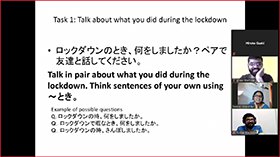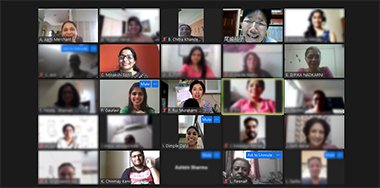Japanese-Language Education Continues Even Amidst COVID-19
The Japan Foundation, New Delhi
OZAKI Hiroko
2020 was a year of great change. The global COVID-19 pandemic had an enormous impact on Japanese-language education in India, and, having been working as a Japanese-Language Chief Advisor in Pune, West India, I felt first-hand the impact of COVID-19 in mid-March 2020. Just before exams for the end of the school year, I was having a lunch meeting with teachers from Tilak Maharashtra University in Pune when, suddenly, the news came in that all educational institutions such as schools and universities in Maharashtra state would be closed. At that time, I couldn't have imagined how long universities would be closed and how much of a long-term impact COVID-19 would have on Japanese-language education. From March 25th, India went into lock down. All of the Japanese-Language Specialists dispatched to India were also instructed to temporarily evacuate back to Japan, and I returned to Japan on a special flight from Mumbai in mid-April. Since then, remote work from Japan has continued for a long, long time.
All classes at Tilak Maharashtra University became online classes. Due to the lockdown and the inability to hold end of year exams for FY2019, the start of the new academic year was delayed by two months from its usual date, and first semester classes began in September 2020. For the first semester, I taught "Research Methodology III" for second-year MA students, and for the second semester, I taught "Teaching Methodology III" for second-year MA students and "Teaching Methodology I" for first-year MA students. "Research Methodology III," which I taught in the first semester, is a 15-week course that covers topics from setting research themes to writing a dissertation, and is a difficult subject for both students and instructors, but it is also a valuable place to discover and nurture promising young Japanese-language human resources who aspire to be engaged in research, and also enables us to provide them with guidance.
In "Teaching Methodology III," which I taught in the second semester, students are taught specific teaching methods and lesson plans for beginner Japanese-language classes, after which the students do mock lessons in class, and, finally, they actually practice teaching in the beginner Japanese-language classes at the extension course for Tilak Maharashtra university. The extension course used to be a regular in-person class, but this time it was an online class. It was also my first time to give students practical training and guidance via online classes, and I was worried whether it would go very well or not. However, the students still required a lot of guidance about the content of the lesson plans and of PPTs, etc., and, even though I had them revise their materials many times, there was no need to worry at all about the online technologies. The students are digital natives to begin with and had been taking online university classes for more than six months, so they were able to use Zoom much better than me, and, even before the practical training, they were able to properly teach already in the mock lesson. To the contrary, their abilities reminded me that I had to acquire more online education skills.

Tilak Online mock lessons for the Tilak Maharashtra University master's course
Prior to COVID-19, as a Japanese-Language Chief Advisor for West India, I used to hold study sessions at Japanese-language teachers’ associations in Pune and Mumbai, study sessions at major educational institutions, and workshops about the Teacher's Training Course (TTC) from the Japanese Language Teachers’ Training Centre, but I haven't been able to do this since the lockdown in March. In December, for the first time in a very long time, I was able to hold a study session for teachers from the Teachers' Association of Japanese (TAJ) in Mumbai. I was worried about how many teachers would come to the TAJ study session, which was being held online for the first time, but when I opened it up, more than 30 teachers participated, which was more people than at the previous in-person study session, and I was both happy and relieved that they had come. The traffic congestion in Mumbai is very bad and it can be difficult to move around, which used to be a problem for people coming to participate in the study session. I think that more people were able to participate this time though because it was online. These Mumbai teachers, who were reunited online after such a long time, were as energetic as before. Seeing familiar teachers harmoniously doing group work with each other and enthusiastically engaging with the workshop made me feel like I was back at the regular study sessions on the campus of the University of Mumbai.
COVID-19 has completely changed the way that we do teaching and training for Japanese-language classes, but in India, there is no change at all in the enthusiasm and efforts of Japanese-language students and teachers. For the final year of my term, it's very unfortunate that I couldn't be in India with these students and teachers, but I think that I was able to support and encourage their learning and study through the online windows. I'm not very good at online trainings, but I was able to conduct online trainings thanks to the strong support of the local staff at the Japan Foundation, New Delhi and my fellow Japanese-Language Specialists. I don't know how long this online world will last, but Japanese-language education in India continues to move. I am convinced that Japanese-language education in West India will continue to develop, and I would like to conclude my final report with my thanks and gratitude to everyone who has assisted me, looked out for me, and taken care of me during my term.

Teachers' Association of Japanese in Mumbai online study session
- What We Do Top
- Arts and Cultural Exchange [Culture]
- Japanese-Language Education Overseas [Language]
- Japanese-Language Education Overseas [Language] Top
- Learn Japanese-language
- Teach Japanese-language
- Take Japanese-Language Test
- Know about Japanese-language education abroad
- The Japanese-Language Institute, Urawa
- The Japanese-Language Institute, Kansai
- Japanese-Language Programs for Foreign Specified Skilled Worker Candidates
- Japanese Language Education for Japanese Children Resident Overseas and for the Descendants of Migrants
- Archives
- Japanese Studies and Global Partnerships [Dialogue]
- JF digital collection
- Other Programs / Programs to Commemorate Exchange Year
- Awards and Prizes
- Publications
